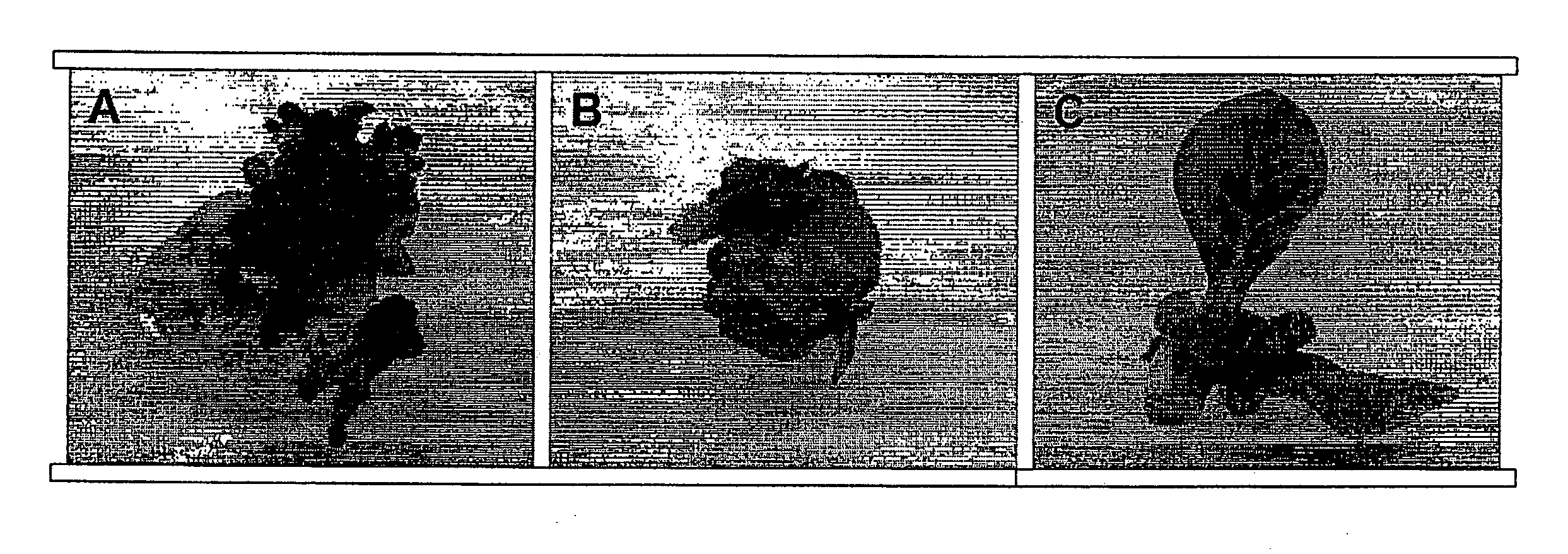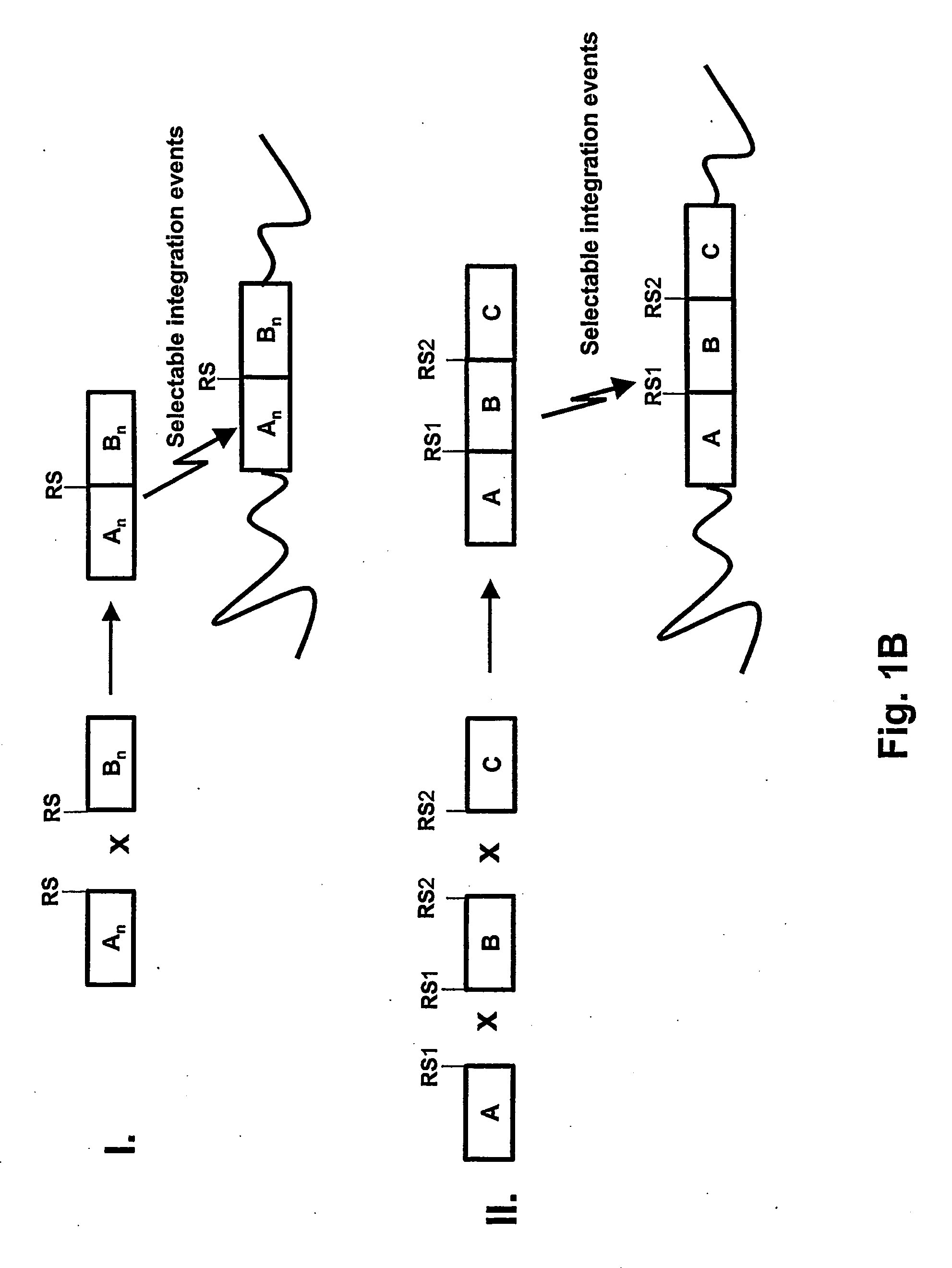Plant transformation with in vivo assembly of a sequence of interest
a plant and sequence technology, applied in the identification of library members, biochemistry apparatus and processes, plant cells, etc., can solve the problem of unelucidated reasons for unexpected high efficiency, and achieve the effect of avoiding the production of transgenic plants or plant cells
- Summary
- Abstract
- Description
- Claims
- Application Information
AI Technical Summary
Benefits of technology
Problems solved by technology
Method used
Image
Examples
example 1
[0119]Vector Design for the Stable Transformation of Dicotyledonous Plants with Split BAR Gene
Design of pICH11150
[0120]This construct was done on the basis of binary vector pICBV-19 (FIG. 2). As a first step of cloning, the target BsaI restriction sites for the intron insertion were introduced into the BAR gene (construct pICH10605, FIG. 2). The BsaI enzyme cuts DNA outside of the recognition site making 4 nucleotides overhang. In the case of pICH10605, the BsaI enzyme was used to introduce splicing acceptor and donor sites for the consequent intron insertion. As a next step, PCR fragment amplified on pICH7410 (FIG. 3) construct with oligos int-ad-9 (5′-tttttggtc cgacctgcaa caataagaac aaaaagtcat aaatt-3′) and attbpr11 (5′-tttaagcttg agctctttcc taggctcgaa gccgcggtgc gggtg-3′) was inserted into pICH10605 using BsaI and HindIII restriction sites. The PCR fragment containing AttB and 3′ part of intron as well as AvrII and SacI restriction sites replaced the GUS expression cassette and 5...
example 2
[0128]Agrobacterium-Mediated Transformation of the Dicotyledonous Plant Nicotiana tabacum (cv Petit Havana) and Arabidopsis thaliana with in planta Assembled T-DNA Region
[0129]The constructs pICH11150 and pICH11170 were immobilized into A. tumefaciens (GV3101) and used for Agrobacterium-mediated leaf discs transformation of Nicotiana plants (Horsh et al., 1985, Science, 227, 1229-1231) using 10 mg / L of phosphinothricin (PPT) as selectable marker. Arabidopsis thaliana plants were transformed using a vacuum infiltration protocol (Bechtold et al., 1993, C. R. Acad. Sci. Paris Life Sci. 316, 1194-1199). Phosphinothricine-resistant (PPTR) transformants were selected by spraying one-week-old plantlets with a 2.5 ml / L of Harvest™ (Agrevo) solution (active ingredient glufosinate, commercially available PPT-analogous compound).
[0130]Regenerated tobacco plants and selected A. thaliana primary transformants were PCR analysed for the presence of an in planta assembled T-DNA region stably integr...
example 3
[0131]Vector Design and Agrobacterium-Mediated Transformation of Monocotyledonous Plants with Split BAR Gene
[0132]For the design of constructs using a split BAR gene to monitor desired T-DNA region assembly in planta, the original constructs pICH11150 and pICH11170 (see EXAMPLE 1) were used. The construct pICH11150 was modified by replacing the Arabidopsis actin2 (PACT2-i,) promoter with rice actin1 (PACT1) promoter (McElroy D, et al., 1991, Mol Gen Genet., 231, 150-160) yielding construct pICH12022 (FIG. 8). The construct pICH11170 was modified by replacing the nopaline synthase promoter (PNOS) driving expression of the BAR gene fragment with the rice actine1 promoter (PACT1) and the NPTII expression cassette with IPT (isopentenyl transferase, Gene Bank Acc. No.: X14410) expression cassette under control of maize ubiquitin gene promoter (PUBQ) (Christensen A H & Quail P H., 1996, Transgenic Res., 5, 213-218) yielding construct pICH12031 (FIG. 8). All manipulations for construct des...
PUM
| Property | Measurement | Unit |
|---|---|---|
| direct nucleic acid | aaaaa | aaaaa |
| frequency | aaaaa | aaaaa |
| size | aaaaa | aaaaa |
Abstract
Description
Claims
Application Information
 Login to View More
Login to View More - R&D
- Intellectual Property
- Life Sciences
- Materials
- Tech Scout
- Unparalleled Data Quality
- Higher Quality Content
- 60% Fewer Hallucinations
Browse by: Latest US Patents, China's latest patents, Technical Efficacy Thesaurus, Application Domain, Technology Topic, Popular Technical Reports.
© 2025 PatSnap. All rights reserved.Legal|Privacy policy|Modern Slavery Act Transparency Statement|Sitemap|About US| Contact US: help@patsnap.com



